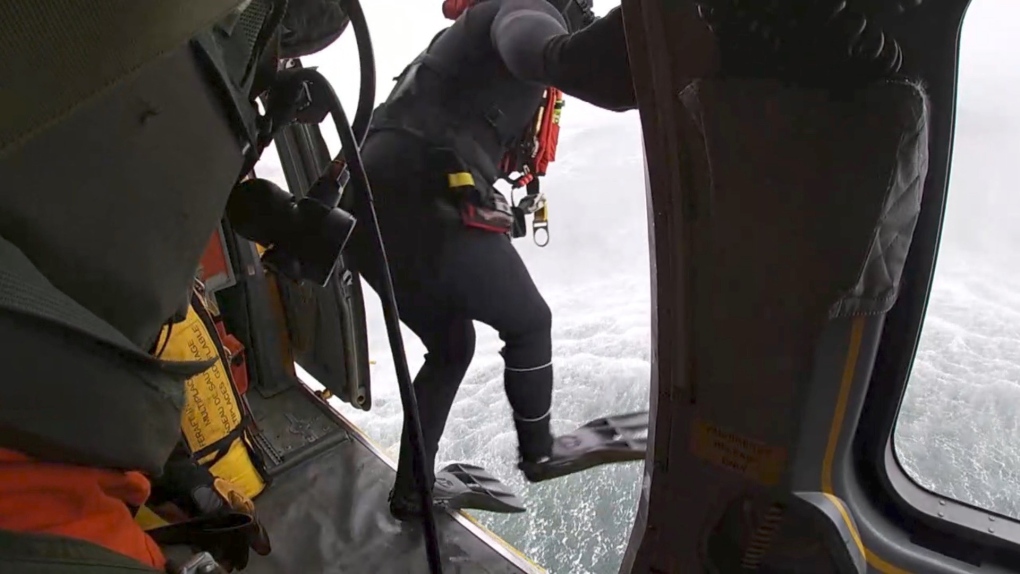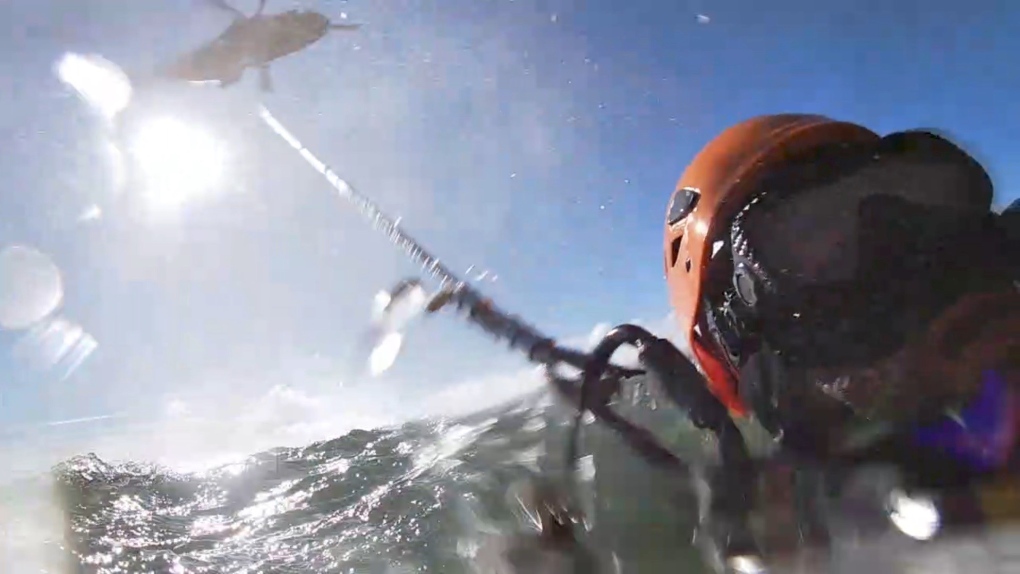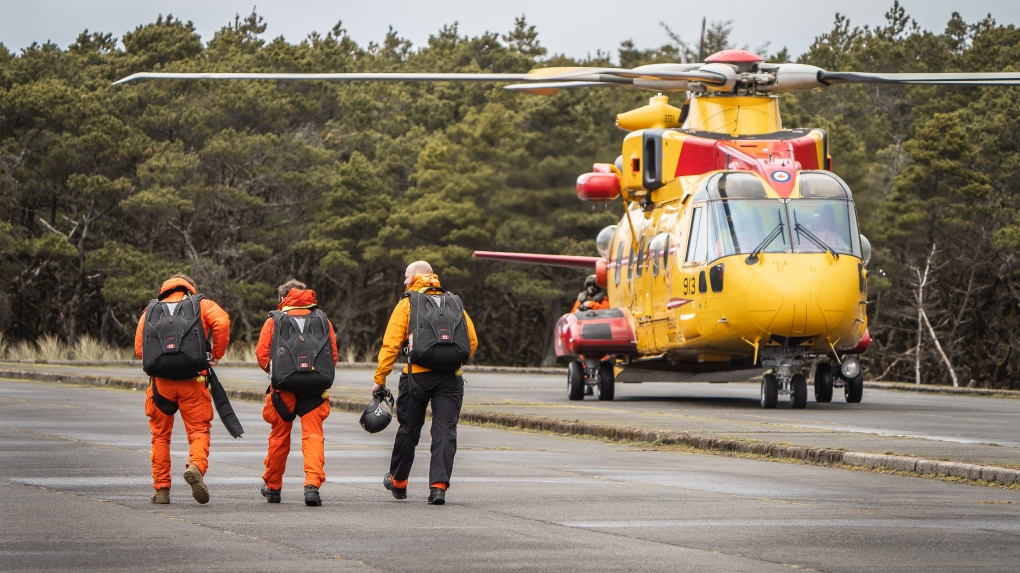Vancouver Island military search and rescue crews train with U.S. Coast Guard
Crews from 19 Wing Comox are back on the ground after attending a week of specialized training in the United States, learning special techniques to get in and out of extreme ocean waves.
"It was awesome to be able to train in a more realistic environment, out of our normal rules," said Master-Cpl. Carl Mozienko of Comox's 442 Transport and Rescue Squadron.
Three pilots, two flight engineers and three search and rescue technicians, spent five days training with members of the U.S. Coast Guard down in Astoria, Oregon, near the mouth of the Columbia River.
The location was chosen because of its rough seas, according to Brad Pigage, a chief aviation survival technician for the Advanced Helicopter Rescue School .
"Cape Disappointment is known for being the graveyard of the Pacific, so a lot of big waves, heavy surf, bad weather, low visibility, all that stuff you can expect right there," he said.
"At the school we pride ourselves at putting these air crew and rescue swimmers and SAR techs through a higher intensity situation, high-risk training, and we mitigate the risk by having more ground party and safety measures in place," said Pigage.
Cpt. Joseph Jacques was one of the Cormorant pilots taking part in the training.
"The U.S. Coast Guard, they’re the subject matter expert in terms of high-surf training, and that school specifically, so we definitely learned a lot from them," he said.
While the SAR techs were the ones diving into the cold ocean, the pilots and crew members onboard the helicopter had their own tasks to master.
 (442 Transport and Rescue Squadron)Jacques says the Cormorant typically hovers around 1.5 metres to three metres above the water but had to stay higher due to the high waves and breaking surf.
(442 Transport and Rescue Squadron)Jacques says the Cormorant typically hovers around 1.5 metres to three metres above the water but had to stay higher due to the high waves and breaking surf.
"We had to adjust our procedure to stay higher and look at the waves, count the waves, communicate between the crew members as to how low it’s safe to descend, and then timing the exit for the SAR-tech to jump on the crest of the waves," Jacques said.
While the crews regularly practice their techniques around the Comox Valley, they do so in fresh water environments avoiding salt water, which is much harder on the aircraft.
"We don’t really typically do it, so it’s only going to be in operations," said Mozienko.
"So we can end up being in that situation without really realistic training," he said. "But going down there gave us that opportunity to swim in big waves."
 (442 Transport and Rescue Squadron)The course also included vertical cliff rescues, urban search and rescue, as well as cave rescues.
(442 Transport and Rescue Squadron)The course also included vertical cliff rescues, urban search and rescue, as well as cave rescues.
"You learn how to enter the cave and going out of the cave and learn how to use the helicopter to get yourself out of it as well, because the currents are going to be different and you don’t want to be stuck inside," Mozienko said.
While the American rescue crews use smaller helicopters than the Cormorant, working alongside their southern counterparts gave the crew from Comox the chance to share techniques.
"They’re flying the MH60 and the 65, the J-Hawk and the Dolphin, which are way smaller," said Jacques.
"They don’t have the same drown draft on their helicopter, don’t have the same weight and references, so we have to tweak the techniques a little bit," he said.
 (442 Transport and Rescue Squadron)
(442 Transport and Rescue Squadron)
CTVNews.ca Top Stories

opinion Tom Mulcair: Prime Minister Justin Trudeau's train wreck of a final act
In his latest column for CTVNews.ca, former NDP leader and political analyst Tom Mulcair puts a spotlight on the 'spectacular failure' of Prime Minister Justin Trudeau's final act on the political stage.
B.C. mayor gets calls from across Canada about 'crazy' plan to recruit doctors
A British Columbia community's "out-of-the-box" plan to ease its family doctor shortage by hiring physicians as city employees is sparking interest from across Canada, says Colwood Mayor Doug Kobayashi.
'There’s no support': Domestic abuse survivor shares difficulties leaving her relationship
An Edmonton woman who tried to flee an abusive relationship ended up back where she started in part due to a lack of shelter space.
opinion King Charles' Christmas: Who's in and who's out this year?
Christmas 2024 is set to be a Christmas like no other for the Royal Family, says royal commentator Afua Hagan. King Charles III has initiated the most important and significant transformation of royal Christmas celebrations in decades.
Baseball Hall of Famer Rickey Henderson dead at 65, reports say
Rickey Henderson, a Baseball Hall of Famer and Major League Baseball’s all-time stolen bases leader, is dead at 65, according to multiple reports.
Arizona third-grader saves choking friend
An Arizona third-grader is being recognized by his local fire department after saving a friend from choking.
Germans mourn the 5 killed and 200 injured in the apparent attack on a Christmas market
Germans on Saturday mourned the victims of an apparent attack in which authorities say a doctor drove into a busy outdoor Christmas market, killing five people, injuring 200 others and shaking the public’s sense of security at what would otherwise be a time of joy.
Blake Lively accuses 'It Ends With Us' director Justin Baldoni of harassment and smear campaign
Blake Lively has accused her 'It Ends With Us' director and co-star Justin Baldoni of sexual harassment on the set of the movie and a subsequent effort to “destroy' her reputation in a legal complaint.
Oysters distributed in B.C., Alberta, Ontario recalled for norovirus contamination
The Canadian Food Inspection Agency has issued a recall due to possible norovirus contamination of certain oysters distributed in British Columbia, Alberta and Ontario.


































